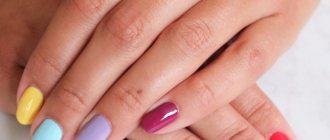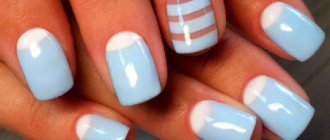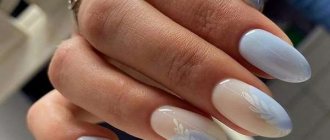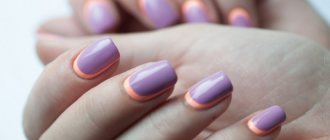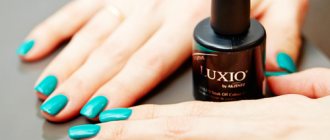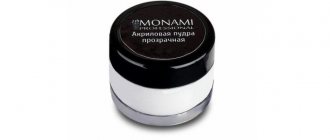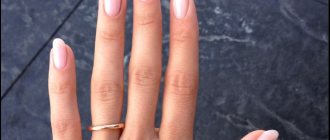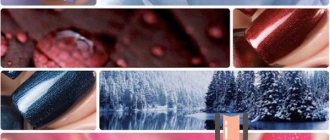Knowing how to mix and match different nail polish colors is the first step to creating the unique and creative manicure you've seen in fashion magazines or on Instagram from nail art professionals.
Even the simplest nail shapes can be given a unique look if you combine the right polish colors with each other, while the wrong colors can ruin the entire manicure, despite the fact that you spent several hours creating it. Today it is considered boring to wear nails painted in one color, so if you do not yet know the principles of creating a stylish manicure, then it is time to learn which colors can be mixed with each other and which cannot.
Learn these basic rules for combining different colored nail polishes and you can rightfully consider yourself a professional manicurist.
What is a color wheel?
The color wheel is a palette of colors in the form of a circle, arranged in such a way that, using special rules, it is possible to determine ideal combinations and see incompatible colors. We will analyze how to do this and all the rules of combination further.
The color wheel in manicure is used to select colors when performing nail design: it allows you to select from one to four colors that perfectly match each other. However, besides this, using the color wheel you can easily learn how to mix colors. This is very convenient if the range of paints or, for example, gel polishes at home is limited.
You can find different types of color wheel depending on the number of rings, but they all start with a basic circle.
The basic circle consists of 12 colors, which are formed as follows:
- Primary or primary colors are three colors: red, yellow and blue. They form the “framework” of the color wheel because they cannot be created by mixing other colors.
- Secondary colors - green, purple and orange - are colors that are obtained by mixing two primary colors: blue + yellow = green, red + blue = purple, yellow + red = orange.
- Tertiary or intermediate colors are made by mixing one of the primary colors with one of the secondary colors. The resulting colors are called this way: the primary color comes first, and the secondary color is written after a hyphen, although many of them have their own separate names. There are only 6 tertiary colors: yellow-green (lime), yellow-orange (gold), red-violet (magenta), red-orange (scarlet), blue-green (turquoise), blue-violet (ink).
The expanded color wheel has several rings in its composition and is divided into sectors, each of which represents shades of the main color of its sector.

Instructions for applying pearlescent tones
Light gel polishes with mother-of-pearl have another problem: the particles of mother-of-pearl are not so small that they are not visible. Their enchanting iridescent glow is accompanied by the pattern of marks that remain from the brush. The smallest particles line up in lines. They are visible in certain lighting. It is very unsightly when these lines intersect or create zigzags. The coating is done in two stages.
- The angle of the brush is 45%; use the brush to place a drop near the cuticle. Carefully reaches towards the free edge.
- Using a brush, paint the left side of the nail with a confident movement, with the cap pointing to the right.
- With a confident brush, paint the right side of the nail, with the cap directed to the left.
- The end is sealed and the hand is placed in the lamp.
The second stage completely repeats the first.
How to Combine Colors Using the Color Wheel
We have become a little familiar with the theory of the color wheel, now let’s look at the rules for combining colors. These rules are based on patterns that allow you to find ideal combinations of two, three or four colors. Let's look at them, starting with the simplest ones - combinations of two colors. If it is difficult for someone to navigate the description, I tried to clearly depict all the diagrams in the drawings.
1 – combinations of two colors
Monochrome scheme - colors are selected from one sector of the color wheel. For example, if you take blue as the main color, then you can add lighter blue and sky colors to it.
A similar scheme is a combination of colors from adjacent sectors, that is, adjacent to each other. This scheme is also called similar.
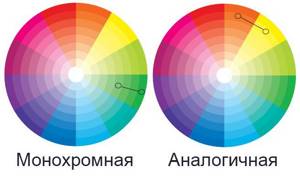
Linear scheme - here colors that are opposite to each other are chosen. That is, if you connect the colors of a circle with a straight line, they form a linear pattern. Its second name is additional or complementary. The linear scheme has variations: for example, you can choose one primary color, and the second will be shifted one sector from the opposite one in the circle (see figure). Other options for a linear scheme will be considered in combinations for three and four colors.
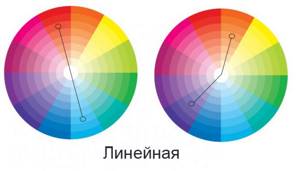
2 – combinations of three colors
Monochrome and linear schemes are also acceptable here, only 3 colors are used.
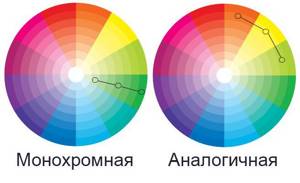
The triangular scheme is the basic version of a combination of three colors, however, there are variations here too. The main ones are combinations when colors are connected by equal segments, that is, an equilateral triangle is obtained. In this case, all colors lie within one ring of the circle. However, options are possible when one or two vertices of the triangle move within the sector, then the triangle will no longer be equilateral (see figure). The triangular scheme also has a second name – triadic.
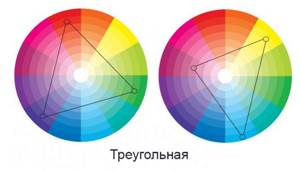
Additional linear scheme - all colors are selected within one color ring: two additional to the main selected color will be the colors from the right and left adjacent sectors to the opposite color.

3 – combinations of four colors
Square scheme or tetraider - the scheme is determined according to a similar principle to the triangular one: colors are selected that are located at the four vertices of the square. A rectangle option is also possible.

Double-linear (or double-complementary) scheme - two colors are taken opposite to each other from the linear scheme, and the second two are also opposite, but from adjacent sectors. A deviation of one sector is possible, as for a linear diagram.
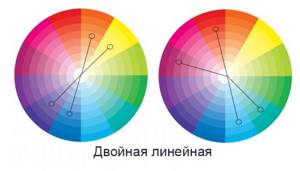
Additional linear scheme (or alternative complementary) - three additional to the main one will be the opposite and two of its neighboring colors.
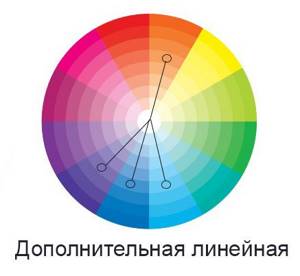
Consumables
To make homemade colored nail enamel, you will need a transparent base (base) for the varnish, as well as cosmetic oil dyes. You can choose the color of the pigments to suit your taste. You can use one color of dye or mix several shades.
If you want to make a shimmering polish, then prepare pieces of cosmetic mica or glitter.
A student at the Vietnam Police Academy shared how she takes care of her facial skin.
A Brazilian travels 36 km by bike every day to take his loved one home.
“We are still friends”: Derevianko commented on the breakup with his wife
You will need the following containers and tools for work:
Concepts of brightness and color saturation
Using the color schemes above, we can find good color combinations for manicures. However, the result may not be what you expect, since you also need to take into account brightness and saturation when choosing colors for your nail design.
The brightness of a color is determined by its saturation with dark or light tones. The further a color is from the center of the color wheel, the brighter it is, and vice versa, the closer the color is to the center, the more saturated with light tones it is, that is, less bright.
The grouping of colors is called color composition. It can be nuanced and contrasting depending on the brightness and saturation of colors.
- There will be a nuanced composition if you take as its basis neighboring colors that have the same saturation - they do not have a dominant color.
- A contrasting composition, on the contrary, is built on the basis of contrasting colors that are opposite in a circle. For example, black and white colors will be very contrasting to each other.
By the way, have you noticed that there is no black, white or their shades in the color wheel?
Fashion Design Examples
Among the fashion trends this season there is an interesting design: it is called “Different Hands”. At the same time, the style is preserved. In light colors you can do the following options:
- One hand is covered with white varnish, the other with delicate lilac (pastel lemon, mint, sakura).
- On one hand there is a white-pink gradient, on the other there is pink gel polish.
- One hand is covered with beige varnish, the middle and ring fingers are blue with a white stripe in the center. The second is covered with white gel polish, the middle and ring fingers are white with a blue stripe in the center.
Any light gel polishes are suitable for creating complex designs. A photo of a possible option shows stamping on accent fingers. A pattern is made in the color of the main coating on a white background. The “Different Hands” design is also used with stamping: they print different patterns in a contrasting color, leaving the background the same.
Naturalness is very popular now. Therefore, a design with drops of transparent gel polish, reminiscent of just rain, is also in fashion. It is still relevant to create a large design on one nail. It could be a butterfly, dragonfly, flower. The design is decorated with rhinestones and drops of gel.
Source of the article: https://city-glam.ru/narashchivanie/kak-smeshat-dva-laka.html
About black and white flowers
Black and white colors are not on the color wheel because they are achromatic colors, meaning they are not colored. This also includes sulfur colors and their shades. The beauty of black and white colors is that they harmoniously combine with any of the colors on the color wheel, and you should pay attention to the contrast of the chosen colors, this has already been mentioned above. Black and white, as well as their shades, can be added to any of the previously listed schemes, thus obtaining up to 5 color combinations.
Lighting nuances
When choosing colors for a manicure, you should also remember the effect of lighting on color.
- Outdoor daylight gives your nail polish a warmer hue,
- When illuminated by a lamp indoors, the varnish will look, on the contrary, colder,
- In summer, it is customary to use brighter colors, since daylight hours are longer and natural light predominates; in winter, the opposite is true.
Consider the texture of the varnish or coating
The texture of the varnish can also affect the perception of color. For example, translucent pearlescent varnishes in the sun and in the shade are completely different colors. And if you apply pearlescent varnish over a colored one, it will also change its shade. Thus, it can be used to create new color combinations.
The same works for other textures. A matte surface will dull the color. The sand texture of the varnish works on the same principle.
Is it possible to combine gel polishes from different companies?
Compatibility of gel polishes from different companies is a matter of practice. Theoretically, mixing coatings from several brands may not produce results due to differences in textures and compositions. Manufacturers of the product do not even recommend combining varnish, base, and top coat from different companies, explaining that the result can be unpredictable - for example, after drying, bald spots will appear on the nails, and chips will form during wear.
In practice, it turns out that combining gel polishes from different manufacturers gives a good effect. To make sure of this, experienced nail art masters recommend first mixing gel polishes, then applying the coating to a tip or one nail, drying it, covering it with a top coat, and evaluating the result.
Mixing colors using the color wheel
The second thing the color wheel is used for is mixing colors to get the desired shade . Mixing varnishes will be problematic - they dry quickly, but paints, gel polishes, gel paints or colored gels mix easily, which allows you to get a large palette and make the desired design.
I have already talked about how secondary and tertiary colors are obtained by mixing. You can always make a color darker or lighter by adding white and black in different proportions. This way you can get colors from one sector of the color wheel.
It is worth remembering that opposite colors on the color wheel can be used in a design, but not mixed together, as this will result in a muddy color that does not look good on the nails.
Is it possible to mix gel polishes with each other?

Nail artists need to mix several gel polishes for various reasons. Women who have purchased a UV lamp and do manicures at home cannot afford to buy a new shade every time. The master may also not have rare tones in his salon. We will discuss further whether it is always possible to mix gel polishes to obtain colors and what nuances need to be taken into account when combining coatings.
Adding dyes
Place one polish mixing ball in each empty bottle. Insert a miniature funnel into the neck of the container.
Scoop up the required amount of dye with the tip of a popsicle stick and pour it into the funnel. You can use one pigment or create combinations of different colors.
If you want to make a polish with a bright and rich color, then you will need a large amount of pigment. In this case, it is better to use a teaspoon. Fill it a quarter or half full with dye and pour the substance into the funnel.
Remember that cosmetic dyes easily stain your hands and surfaces. Sometimes it can be difficult to scrub them off. Therefore, you need to pour pigments into the funnel very carefully.
If there is little snow, there will be no harvest: December 16 is Ivan the Silent Day
Smooth and fresh skin: dermaplaning, or why a woman needs to shave her face
Women's jeans: before you buy them, you need to pay attention to one detail
If you are using mica or glitter, add it to the funnel after the dye.
